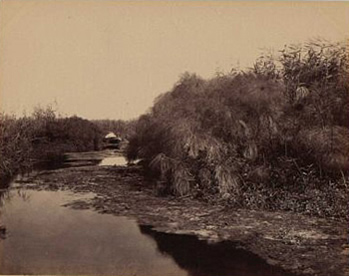
The Ciane and Anapo Rivers of Syracuse
A single mouth connects two rivers, the Ciane (from a Greek word meaning "blue-green") and the Anapo. For some time it seemed that the first name was ironic, because of the risk that industrialization posed to the survival of these waterways. An excessive consumption of freshwater to meet the needs of industry had, in fact, caused them to refill with sea water, making the rivers brackish.
This can be particularly disastrous for the very element for which this river complex is famous: its papyrus vegetation, unique in all of Western Europe. On these two rivers papyrus, a plant of North Africa, had in fact found (it is unclear if it was brought by the Greeks, Romans or Arabs) the only place in Europe where it has flourished as a wild plant.
This river plant was valuable because working its pith produced the ancient equivalent of paper, the very papyrus from which the word "paper" in many European languages (paper, papel, papier...) derives its name.
An erudite Syracusan even managed, in the 18th century, to rediscover the secret of "papyrus" production, which has continued since then in Syracuse both for scholarship and for the production of souvenirs, and has reached such a level of competence that the Papyrus Museum of Syracuse is also entrusted with the restoration of precious and fragile ancient Egyptian papyri.
In
the 19th century a visit to the papyrus plants was considered a must for
every tourist, equally important as the Greek
and Roman monuments, the Quarries,
or the Duomo.
Tourists drifted in rowboats between plants
as high as six meters, which rose, and continue to rise, directly from
the water, enjoying "North African" nature.
 |
| The Anapo river in the 19th century. Photo by Giorgio Sommer (1834-1914) |
All of this seriously threatened to disappear.
First, during the reclamation of the late
19th century (during which they drained the "marshes" in which the double
river tended to mire), they eliminated almost all reservoirs of slowly
running water that the papyrus prefers, leaving in their place a faster
moving stream in which river reeds thrive better.
Then, especially after the war, the rise
of salt water, as stated previously, seemed to provide the final blow.
The patches of papyrus were yellowing
and emaciated and seemed destined to disappear.
Fortunately, the worst has been averted in extremis (also thanks to the citizens of Syracuse and the associations that long fought to save the area) both by the establishment in 1984 of the "Ciane River Nature Reserve - Saline di Siracusa" and because the excessive salinity of the water was rendered unfit even for industries, which therefore, willingly or not, were forced to stop pumping it.
Today tourists can travel by boat along these rivers in which the papyrus plants have recovered splendidly, to the point of turning the river into a sort of "tunnel" lined with vegetation; a natural setting unique in Europe.
How to reach the Ciane and Anapo rivers
from the Algilà
Ortigia Charme Hotel.
To reach the Ciane and Anapo rivers one
must cross the gulf that constitutes one side of the island of Ortigia.
This can be done either by sea or by land.
To go by sea, cross
the port of Syracuse, using – reservations required – the
private boat service, which makes the crossing and then travels up
the rivers. The reception desk at the Algilà Ortigia Charme Hotel
is pleased to provide information on the schedules and boat landings
(which depart a few hundred meters from the hotel itself).
Only during the summer the possibility
exists to rent a boat. Ask at the reception desk.
By car or bike
one needs to travel the Siracusa-Canicattini Bagni motorway, and then follow
the signs.
In the vicinity of the intersection between
the road and the river one finds the boarding area for the tourist boats
that travel along the river; it is strongly recommended to book
the trip in advance, especially during the high season, to avoid the risk
of finding no small boats available.
It is possible to obtain at the reception
desk of the Hotel the phone numbers of some of the companies engaged in
this service.
Visitor Information.
Access to the area is free.
Back to TOURISM IN SYRACUSE, SICILY